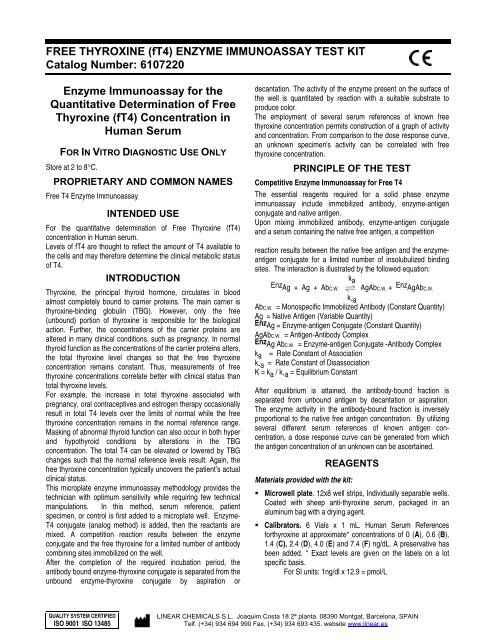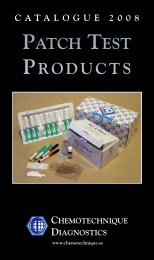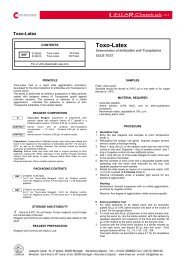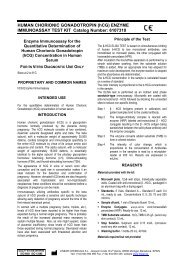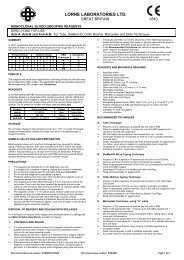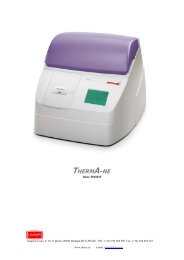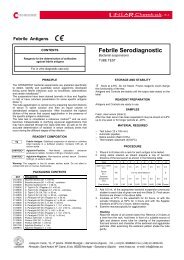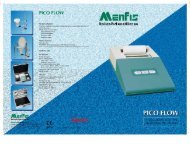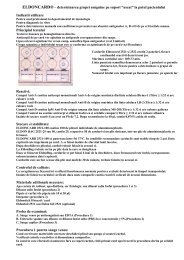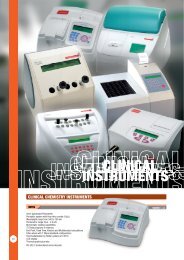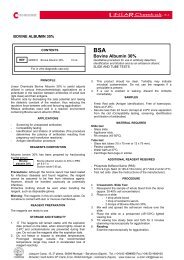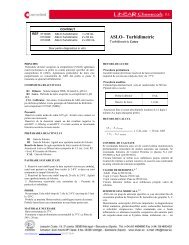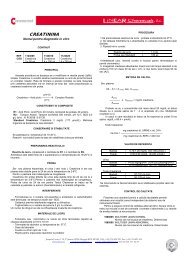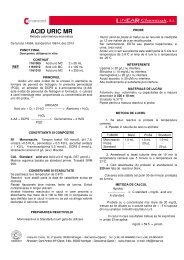FREE THYROXINE (fT4) ENZYME IMMUNOASSAY TEST ... - Linear
FREE THYROXINE (fT4) ENZYME IMMUNOASSAY TEST ... - Linear
FREE THYROXINE (fT4) ENZYME IMMUNOASSAY TEST ... - Linear
Create successful ePaper yourself
Turn your PDF publications into a flip-book with our unique Google optimized e-Paper software.
<strong>FREE</strong> <strong>THYROXINE</strong> (<strong>fT4</strong>) <strong>ENZYME</strong> <strong>IMMUNOASSAY</strong> <strong>TEST</strong> KIT<br />
Catalog Number: 6107220<br />
Enzyme Immunoassay for the<br />
Quantitative Determination of Free<br />
Thyroxine (<strong>fT4</strong>) Concentration in<br />
Human Serum<br />
FOR IN VITRO DIAGNOSTIC USE ONLY<br />
Store at 2 to 8°C.<br />
PROPRIETARY AND COMMON NAMES<br />
Free T4 Enzyme Immunoassay<br />
INTENDED USE<br />
For the quantitative determination of Free Thyroxine (<strong>fT4</strong>)<br />
concentration in Human serum.<br />
Levels of <strong>fT4</strong> are thought to reflect the amount of T4 available to<br />
the cells and may therefore determine the clinical metabolic status<br />
of T4.<br />
INTRODUCTION<br />
Thyroxine, the principal thyroid hormone, circulates in blood<br />
almost completely bound to carrier proteins. The main carrier is<br />
thyroxine-binding globulin (TBG). However, only the free<br />
(unbound) portion of thyroxine is responsible for the biological<br />
action. Further, the concentrations of the carrier proteins are<br />
altered in many clinical conditions, such as pregnancy. In normal<br />
thyroid function as the concentrations of the carrier proteins alters,<br />
the total thyroxine level changes so that the free thyroxine<br />
concentration remains constant. Thus, measurements of free<br />
thyroxine concentrations correlate better with clinical status than<br />
total thyroxine levels.<br />
For example, the increase in total thyroxine associated with<br />
pregnancy, oral contraceptives and estrogen therapy occasionally<br />
result in total T4 levels over the limits of normal while the free<br />
thyroxine concentration remains in the normal reference range.<br />
Masking of abnormal thyroid function can also occur in both hyper<br />
and hypothyroid conditions by alterations in the TBG<br />
concentration. The total T4 can be elevated or lowered by TBG<br />
changes such that the normal reference levels result. Again, the<br />
free thyroxine concentration typically uncovers the patient’s actual<br />
clinical status.<br />
This microplate enzyme immunoassay methodology provides the<br />
technician with optimum sensitivity while requiring few technical<br />
manipulations. In this method, serum reference, patient<br />
specimen, or control is first added to a microplate well. Enzyme-<br />
T4 conjugate (analog method) is added, then the reactants are<br />
mixed. A competition reaction results between the enzyme<br />
conjugate and the free thyroxine for a limited number of antibody<br />
combining sites immobilized on the well.<br />
After the completion of the required incubation period, the<br />
antibody bound enzyme-thyroxine conjugate is separated from the<br />
unbound enzyme-thyroxine conjugate by aspiration or<br />
decantation. The activity of the enzyme present on the surface of<br />
the well is quantitated by reaction with a suitable substrate to<br />
produce color.<br />
The employment of several serum references of known free<br />
thyroxine concentration permits construction of a graph of activity<br />
and concentration. From comparison to the dose response curve,<br />
an unknown specimen's activity can be correlated with free<br />
thyroxine concentration.<br />
PRINCIPLE OF THE <strong>TEST</strong><br />
Competitive Enzyme Immunoassay for Free T4<br />
The essential reagents required for a solid phase enzyme<br />
immunoassay include immobilized antibody, enzyme-antigen<br />
conjugate and native antigen.<br />
Upon mixing immobilized antibody, enzyme-antigen conjugate<br />
and a serum containing the native free antigen, a competition<br />
reaction results between the native free antigen and the enzymeantigen<br />
conjugate for a limited number of insolubulized binding<br />
sites. The interaction is illustrated by the followed equation:<br />
k a<br />
Enz Ag + Ag + AbC.W. AgAbC.W. + Enz AgAbC.W.<br />
k -a<br />
AbC.W. = Monospecific Immobilized Antibody (Constant Quantity)<br />
Ag = Native Antigen (Variable Quantity)<br />
Enz Ag = Enzyme-antigen Conjugate (Constant Quantity)<br />
AgAbC.W. = Antigen-Antibody Complex<br />
Enz Ag AbC.W. = Enzyme-antigen Conjugate -Antibody Complex<br />
k a = Rate Constant of Association<br />
k -a = Rate Constant of Disassociation<br />
K = k a / k -a = Equilibrium Constant<br />
After equilibrium is attained, the antibody-bound fraction is<br />
separated from unbound antigen by decantation or aspiration.<br />
The enzyme activity in the antibody-bound fraction is inversely<br />
proportional to the native free antigen concentration. By utilizing<br />
several different serum references of known antigen concentration,<br />
a dose response curve can be generated from which<br />
the antigen concentration of an unknown can be ascertained.<br />
REAGENTS<br />
Materials provided with the kit:<br />
• Microwell plate. 12x8 well strips, Individually separable wells.<br />
Coated with sheep anti-thyroxine serum, packaged in an<br />
aluminum bag with a drying agent.<br />
• Calibrators. 6 Vials x 1 mL. Human Serum References<br />
forthyroxine at approximate* concentrations of 0 (A), 0.6 (B),<br />
1.4 (C), 2.4 (D), 4.0 (E) and 7.4 (F) ng/dL. A preservative has<br />
been added. * Exact levels are given on the labels on a lot<br />
specific basis.<br />
For SI units: 1ng/dl x 12.9 = pmol/L<br />
QUALITY SYSTEM CERTIFIED<br />
ISO 9001 ISO 13485<br />
LINEAR CHEMICALS S.L. Joaquim Costa 18 2ª planta. 08390 Montgat, Barcelona, SPAIN<br />
Telf. (+34) 934 694 990 Fax. (+34) 934 693 435. website www.linear.es
<strong>FREE</strong> <strong>THYROXINE</strong> (<strong>fT4</strong>) <strong>ENZYME</strong> <strong>IMMUNOASSAY</strong> <strong>TEST</strong> KIT<br />
Catalog Number: 6107220<br />
• Enzyme-antigen Conjugate. Thyroxine-horseradish<br />
peroxidase (HRP) conjugate in a bovine albumin-stabilizing<br />
matrix. A preservative has been added. Ready-to-use. 10.5<br />
mL.<br />
• Wash Solution Concentrate. Surfactant in phosphate<br />
buffered saline. A preservative has been added. 20mL.<br />
• TMB Substrate. H2O2-TMB 0.25 g/L (avoid any skin contact).<br />
12 mL<br />
• Stop Solution. Sulphuric acid 0.15 mol/L (corrosive: avoid any<br />
skin contact). 12 mL<br />
PRECAUTIONS<br />
All products that contain human serum have been found to be<br />
non-reactive for Hepatitis B Surface Antigen, HIV 1&2 and HCV<br />
Antibodies by FDA required tests. Since no known test can offer<br />
complete assurance that infectious agents are absent, all human<br />
serum products should be handled as potentially hazardous and<br />
capable of transmitting disease. Good laboratory procedures for<br />
handling blood products can be found in the Center for Disease<br />
Control / National Institute of Health, "Biosafety in Microbiological<br />
and Biomedical Laboratories," 2nd Edition, 1988, HHS Publication<br />
No. (CDC) 88-8395.<br />
SPECIMEN COLLECTION AND PREPARATION<br />
Use fresh serum. Samples can be stored at 2-8°C for 2 days. For<br />
longer periods, samples should be frozen (-20°C). Avoid repeated<br />
freezing and thawing.<br />
Grossly hemolyzed, lipemic or microbially contaminated<br />
specimens may interfere with the performance of the test and<br />
should not be used. Neither Bilirubin nor Hemolysis have<br />
significant effect on the procedure.<br />
The cross-reactivity of the thyroxine antibody to selected<br />
substances was evaluated by adding the interfering substance to<br />
a serum matrix at various concentrations. The cross-reactivity was<br />
calculated by deriving a ratio between dose of interfering<br />
substance to dose of thyroxine needed to displace the same<br />
amount of tracer.<br />
SubstanceCross Reactivity<br />
Concentration<br />
l–Thyroxine1.1.0000 ---<br />
d-Thyroxine 0.9800<br />
10 µg/dL<br />
d-Triiodothyronine 0.0150<br />
100 µg/dL<br />
l–Triiodothyronine 0.0300<br />
100 µg/dL<br />
lodothyrosine 0.000<br />
100 µg/mL<br />
Diiodothyrosine 0.0001<br />
100 µg/mL<br />
Diiodothyronine 0.0001<br />
100 µg/mL<br />
Materials required but not provided:<br />
• Multichannel pipettes and micropipettes (Precision >1.5%)<br />
and disposable tips.<br />
• Microplate reader with a 450 nm filter. Reference filter of 620<br />
or 655 nm is advisable.<br />
• Manual or automated wash system.<br />
• Absorbent paper of blotting the microplate wells.<br />
• Distilled or deionised water.<br />
• Timer.<br />
REAGENT PREPARATION<br />
• Wash Buffer. Dilute contents of Wash Concentrate to 1000<br />
mL with distilled or deionized water in a suitable storage<br />
container. Store at room temperature until expiration date<br />
printed on concentrate label. It is essential that all the contents<br />
of the wash buffer concentrate dissolve. Crystal formation in<br />
the Wash Concentrate can be eliminated by briefly (approx. 5<br />
minutes) heating in a water bath at 37°C or storing the Wash<br />
Concentrate at room temperature.<br />
ASSAY PROCEDURE<br />
Before proceeding with the assay, bring all reagents, serum<br />
references and controls to room temperature (20 - 27°C).<br />
1. Format the microplates’ wells for each serum reference,<br />
control and patient specimen to be assayed in duplicate.<br />
Replace any unused microwell strips back into the<br />
aluminum bag, seal and store at 2-8°C<br />
2. Pipette 0.050 mL (50µL) of the appropriate serum<br />
reference, control or specimen into the assigned well.<br />
3. Add 0.100 mL (100µL) of <strong>fT4</strong>-enzyme conjugate<br />
solution to all wells.<br />
4. Swirl the microplate gently for 20-30 seconds to mix<br />
and cover.<br />
5. Incubate 60 minutes at room temperature.<br />
6. Discard the contents of the microplate by decantation or<br />
aspiration. If decanting, blot the plate dry with absorbent<br />
paper.<br />
7. Add 300 µL of wash buffer (see Reagent<br />
Preparation Section), decant (tap and blot) or<br />
aspirate. Repeat two (2) additional times for a total<br />
of three (3) washes. An automatic or manual plate<br />
washer can be used. Follow the manufacturer’s<br />
instruction for proper usage. If a squeeze bottle is<br />
employed, fill each well by depressing the container<br />
(avoiding air bubbles) to dispense the wash. Decant<br />
the wash and repeat two (2) additional times.<br />
8. Add 0.100 mL (100µL) of TMB-Substrate solution to all<br />
wells. Always add reagents in the same order to<br />
minimize reaction time differences between wells.<br />
9. Incubate at room temperature for fifteen (15) minutes.<br />
10. Add 0.100mL (100µL) of stop solution to each well and<br />
gently mix for 15-20 seconds. Always add reagents in<br />
the same order to minimize reaction time differences<br />
between wells.<br />
QUALITY SYSTEM CERTIFIED<br />
ISO 9001 ISO 13485<br />
LINEAR CHEMICALS S.L. Joaquim Costa 18 2ª planta. 08390 Montgat, Barcelona, SPAIN<br />
Telf. (+34) 934 694 990 Fax. (+34) 934 693 435. website www.linear.es
<strong>FREE</strong> <strong>THYROXINE</strong> (<strong>fT4</strong>) <strong>ENZYME</strong> <strong>IMMUNOASSAY</strong> <strong>TEST</strong> KIT<br />
Catalog Number: 6107220<br />
11. Read the absorbance in each well at 450 nm (using a<br />
reference wavelength of 620-630 nm to minimize well<br />
imperfections) in a microplate reader. The results<br />
should be read within thirty (30) minutes of adding the<br />
stop solution.<br />
QUALITY CONTROL<br />
Each laboratory should assay controls at levels in the hypothyroid,<br />
euthyroid and hyperthyroid range for monitoring assay<br />
performance. These controls should be treated as unknowns and<br />
values determined in every test procedure performed. Quality<br />
control charts should be maintained to follow the performance of<br />
the supplied reagents. Pertinent statistical methods should be<br />
employed to ascertain trends. The individual laboratory should set<br />
acceptable assay performance limits. Other parameters that<br />
should be monitored include he 80, 50 and 20% intercepts of the<br />
standard curve for run-to-run reproducibility. In addition, maximum<br />
absorbance should be consistent with past experience. Significant<br />
deviation from established performance can indicate unnoticed<br />
change in experimental conditions or degradation of kit reagents.<br />
Fresh reagents should be used to determine the reason for the<br />
variations.<br />
CALCULATION OF RESULTS<br />
A dose response curve is used to ascertain the concentration of<br />
free thyroxine in unknown specimens.<br />
1. Record the absorbance obtained from the printout of the<br />
microplate reader as outlined in Example 1.<br />
2. Plot the absorbance for each duplicate serum reference<br />
versus the corresponding free T4 concentration in ng/dl on<br />
linear graph paper (do not average the duplicates of the<br />
serum references before plotting).<br />
3. Draw the best-fit curve through the plotted points.<br />
4. To determine the concentration of <strong>fT4</strong> for an unknown, locate<br />
the average absorbance of the duplicates for each unknown<br />
on the vertical axis of the graph, find the intersecting point on<br />
the curve, and read the concentration (in ng/dl) from the<br />
horizontal axis of the graph (the duplicates of the unknown<br />
may be averaged as indicated). In the following example, the<br />
average absorbance 1.123 (intersects the standard curve at<br />
(8.1 ng/dL) <strong>fT4</strong> concentration (See Figure 1).<br />
EXAMPLE 1<br />
WELL SERUM REFERENCES ABSORBANCE<br />
1 0.0 ng/dL 2.462<br />
2 0.0 ng/dL 2.531<br />
3 0.3 ng/dL 2.330<br />
4 0.3 ng/dL 2.255<br />
5 0.95 ng/dL 1.915<br />
6 0.95 ng/dL 1.892<br />
7 2.1 ng/dL 1.328<br />
8 2.1 ng/dL 1.262<br />
9 3.6 ng/dL 0.834<br />
10 3.6 ng/dL 0.804<br />
11 7.0 ng/dL 0.399<br />
12 7.0 ng/dL 0.42<br />
Unknown Avg.<br />
WELL I. D. O.D O.D Value<br />
13 Unknown #1 1.783<br />
14 Unknown #1 1.676 1.730 1.3 ng/dL<br />
*The data presented in Example 1 and Figure 1 are for illustration<br />
Absorbance<br />
3<br />
2,5<br />
2<br />
1,5<br />
1<br />
0,5<br />
0<br />
Unknown 1<br />
Figure 1<br />
0 0,5 1 1,5 2 2,5 3 3,5 4 4,5 5 5,5 6 6,5 7 7,5<br />
Free T4 Concentration (ng/dl)<br />
only and should not be used in lieu of a standard curve prepared<br />
with each assay.<br />
Q.C. PARAMETERS<br />
Maximum Absorbance (O calibrator) = 1.5 – 2.7<br />
LIMITATIONS OF THE PROCEDURE<br />
1. Assay Performance<br />
It is important that the time of reaction in each well is held<br />
constant for reproducible results. Pipetting of samples should<br />
not extend beyond ten (10) minutes to avoid assay drift. If<br />
more than one (1) plate is used, it is recommended to repeat<br />
the dose response curve.<br />
Addition of the substrate solution initiates a kinetic reaction,<br />
which is terminated by the addition of the stop solution.<br />
Therefore, the addition of the substrate and the stopping<br />
solution should be added in the same sequence to eliminate<br />
any time deviation during reaction.<br />
Plate readers measure vertically. Do not touch the bottom of<br />
the wells.<br />
QUALITY SYSTEM CERTIFIED<br />
ISO 9001 ISO 13485<br />
LINEAR CHEMICALS S.L. Joaquim Costa 18 2ª planta. 08390 Montgat, Barcelona, SPAIN<br />
Telf. (+34) 934 694 990 Fax. (+34) 934 693 435. website www.linear.es
<strong>FREE</strong> <strong>THYROXINE</strong> (<strong>fT4</strong>) <strong>ENZYME</strong> <strong>IMMUNOASSAY</strong> <strong>TEST</strong> KIT<br />
Catalog Number: 6107220<br />
Failure to remove adhering solution adequately in the<br />
aspiration or decantation wash step(s) may result in poor<br />
replication and spurious results.<br />
Sample(s), which are contaminated microbiologically, should<br />
not be used in the assay. Highly lipemeic or hemolysed<br />
specimen(s) should similarly not be used<br />
2. Interpretation<br />
If computer controlled data reduction is used to interpret the<br />
results of the test, it is imperative that the predicted values<br />
for the calibrators fall within 10% of the assigned<br />
concentrations. Total serum thyroxine concentration is<br />
dependent upon a multiplicity of factors: thyroid gland<br />
function and its regulation, thyroxine binding globulin (TBG)<br />
concentration, and the binding of thyroxine to TBG (3,4).<br />
Thus, total thyroxine concentration alone is not sufficient to<br />
assess clinical status.<br />
Total serum thyroxine values may be elevated under<br />
conditions such as pregnancy or administration of oral<br />
contraceptives. A T3 uptake test may be performed to<br />
estimate the relative TBG concentration in order to determine<br />
if the elevated T4 is caused by TBG variation.<br />
A decrease in total thyroxine values is found with<br />
protein-wasting diseases, certain liver diseases and<br />
administration of testosterone, diphenylhydantoin or<br />
salicylates. A table of interfering drugs and conditions which<br />
affect total thyroxine values has been compiled by the<br />
Journal of the American Association of Clinical Chemists.<br />
1. "NOT INTENDED FOR NEWBORN SCREENING"<br />
EXPECTED VALUES<br />
A study of euthyroid adult population was undertaken to<br />
determine expected values for the Free T4 EIA Test System. The<br />
mean (R) values, standard deviations (σ) and expected ranges<br />
(±2 σ) are presented in Table 1.<br />
TABLE 1<br />
Expected Values for the Free T4 EIA Test System<br />
(in ng/dL)<br />
Adult Pregnancy<br />
(110 specimens) (30specimens)<br />
Mean (X) 1.4 1.5<br />
Standard Deviation (σ) 0.6 0.7<br />
Expected Ranges (±2 σ) 0.8 – 2.0 0.8 – 2.2<br />
It is important to keep in mind that establishment of a range of<br />
values which can be expected to be found by a given method for<br />
a population of "normal"-persons is dependent upon a multiplicity<br />
of factors: the specificity of the method, the population tested and<br />
the precision of the method in the hands of the analyst. For these<br />
reasons each laboratory should depend upon the range of<br />
expected values established by the Manufacturer only until an<br />
in-house range can be determined by the analysts using the<br />
method with a population indigenous to the area in which the<br />
laboratory is located.<br />
PERFORMANCE CHARACTERISTICS<br />
A. Precision<br />
The within and between assay precision of the <strong>fT4</strong> Microplate EIA<br />
Test System were determined by analyses on three different<br />
levels of pool control sera. The number, mean values, standard<br />
deviation (σ) and coefficient of variation for each of these control<br />
sera are presented in Table 2 and Table 3.<br />
TABLE 2<br />
Within Assay Precision (Values in ng/dl )<br />
Sample N X S.D. C.V.<br />
Low 16 0.45 0.035 7.8%<br />
Normal 16 1.45 0.063 4.3%<br />
High 16 3.3 0.215 6.5%<br />
TABLE 3<br />
Between Assay Precision (Values in ng/dL)<br />
Sample N X σ C.V.<br />
Low 10 0.48 0.052 10.8%<br />
Normal 10 1.41 0.085 6.0%<br />
High 10 3.49 0.279 7.9%<br />
*As measured in ten experiments in duplicate over a ten day<br />
period.<br />
B. Accuracy<br />
The T4 Microplate EIA Test System was compared with a coated<br />
tube radioimmunoassay method. Biological specimens from<br />
hypothyroid, euthyroid and hyperthyroid populations were used<br />
(The values ranged from 0.1 ng/dL – 8 ng/dL). The total number<br />
of such specimens was 85. The least square regression equation<br />
and the correlation coefficient were computed for this <strong>fT4</strong> EIA in<br />
comparison with the reference method. The data obtained is<br />
displayed in Table 4.<br />
TABLE 4<br />
Least Square Regression<br />
Correlation<br />
Method Mean (x) Analysis Coefficient<br />
This Method 1.47 y = 0.12+0.962(x) 0.965<br />
Reference 1.42<br />
Only slight amounts of bias between this method and the<br />
reference method are indicated by the closeness of the mean<br />
values. The least square regression equation and correlation<br />
coefficient indicates excellent method agreement.<br />
C. Sensitivity<br />
QUALITY SYSTEM CERTIFIED<br />
ISO 9001 ISO 13485<br />
LINEAR CHEMICALS S.L. Joaquim Costa 18 2ª planta. 08390 Montgat, Barcelona, SPAIN<br />
Telf. (+34) 934 694 990 Fax. (+34) 934 693 435. website www.linear.es
<strong>FREE</strong> <strong>THYROXINE</strong> (<strong>fT4</strong>) <strong>ENZYME</strong> <strong>IMMUNOASSAY</strong> <strong>TEST</strong> KIT<br />
Catalog Number: 6107220<br />
The thyroxine procedure has a sensitivity of 0.05 ng/dL. The<br />
sensitivity was ascertained by determining the variability of the 0<br />
ng/dl serum calibrator and using the 2σ (95% certainty) statistic to<br />
calculate the minimum dose.<br />
REFERENCES<br />
1. Barker, S.B., "Determination of Protein Bound Iodine.",Joumal<br />
Biological Chemistry, 173, 175, (1948).<br />
2. Chopra, I.J., Solomon, D.H., and Ho, R.S., "A<br />
Radioimmunoassay of Thyroxine", J. Clinical EndocrinoL, 33,<br />
865 (1971).<br />
3. Young, D.S., Pestaner, L.C., and Gilberman, U., "Effects of<br />
Drugs on Clinical Laboratory Tests", Clinical Chemistry, 21,<br />
3660 (1975).<br />
4. Sterling, L., Diagnosis and Treatment of Thyroid Disease,<br />
Cleveland , CRC Press, P. 19-51 (1975).<br />
6107220-3/0809<br />
R2.ing<br />
QUALITY SYSTEM CERTIFIED<br />
ISO 9001 ISO 13485<br />
LINEAR CHEMICALS S.L. Joaquim Costa 18 2ª planta. 08390 Montgat, Barcelona, SPAIN<br />
Telf. (+34) 934 694 990 Fax. (+34) 934 693 435. website www.linear.es


